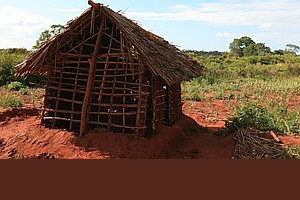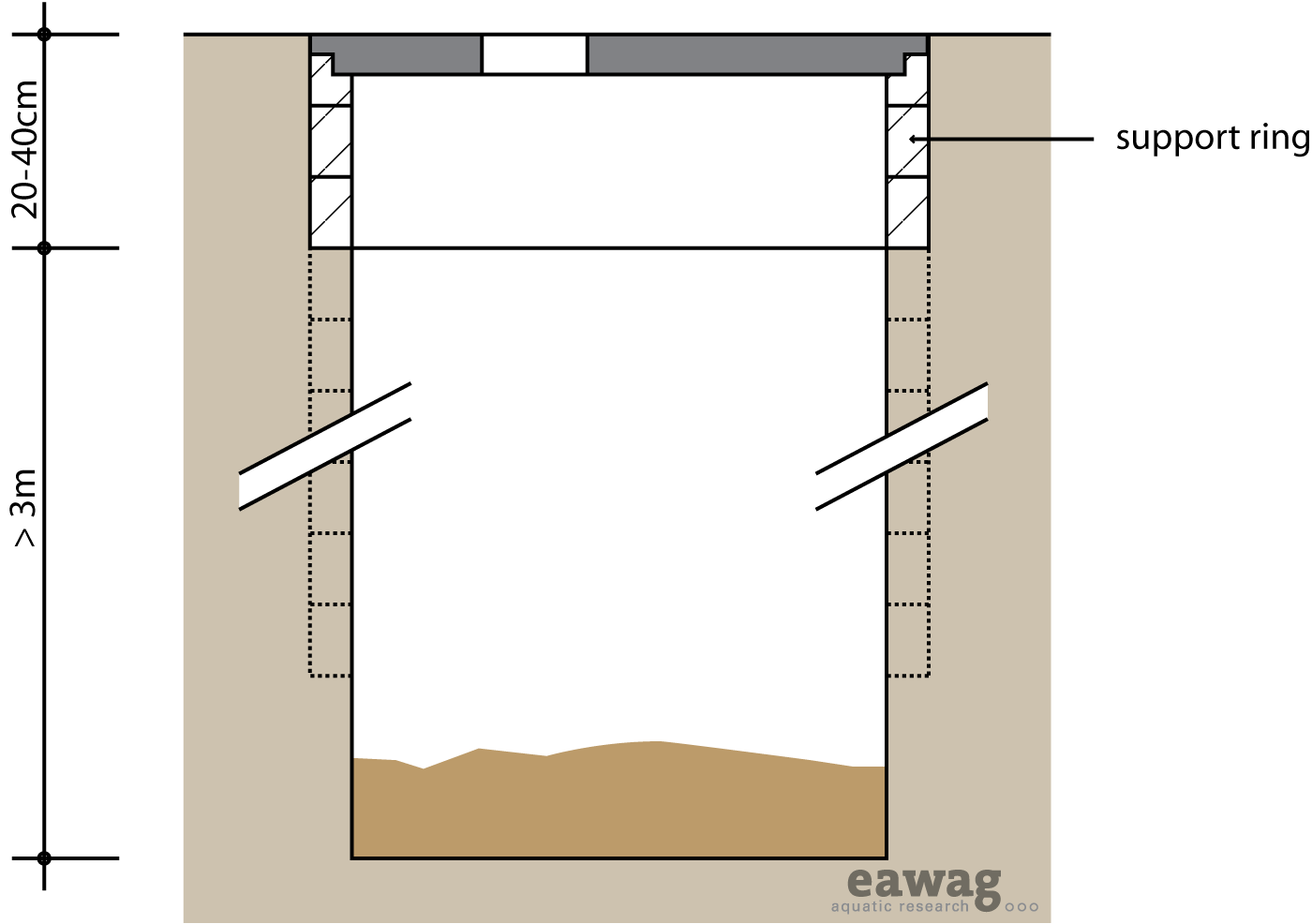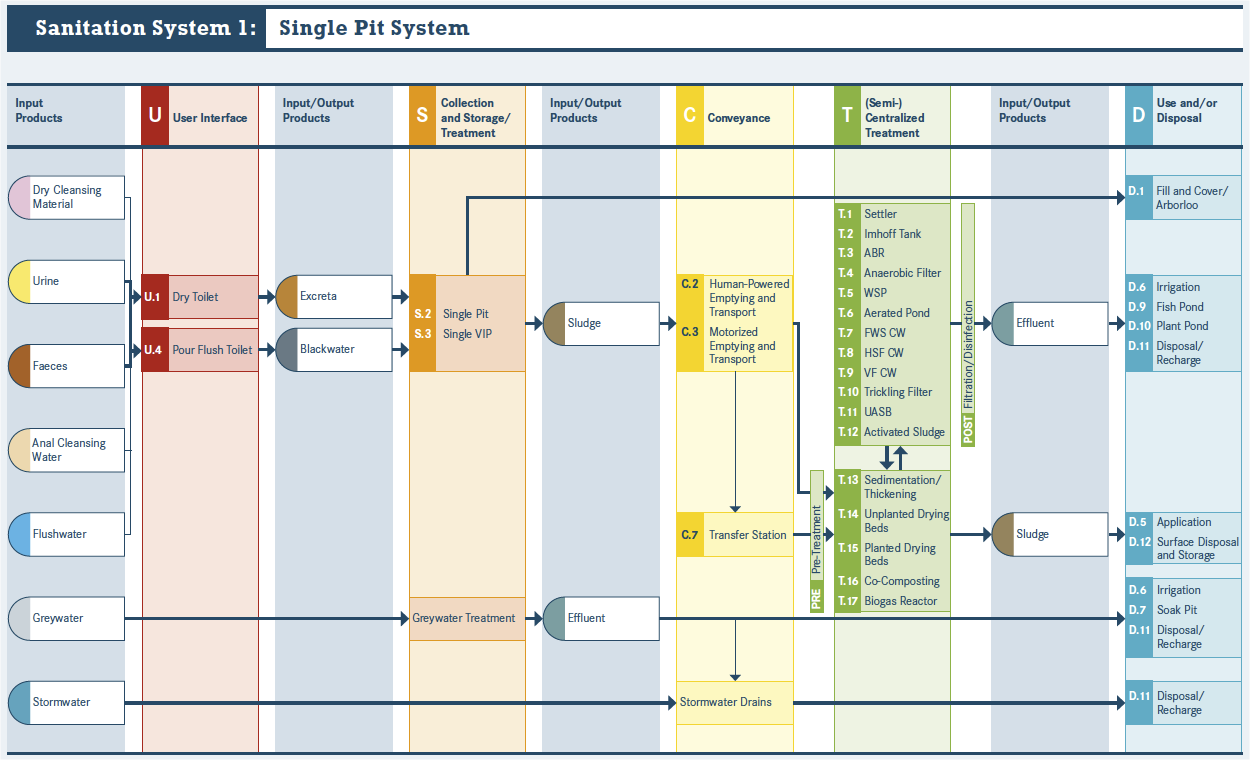Single Pit
|
|||||||||||||||||||||||||||
The Single Pit is one of the most widely used sanitation technologies. Excreta, along with anal cleansing materials (water or solids) are deposited into a pit. Lining the pit prevents it from collapsing and provides support to the superstructure.
This system is based on the use of a single pit technology to collect and store Excreta. The system can be used with or without Flushwater, depending on the User Interface. Inputs to the system can include Urine, Faeces, Anal Cleansing Water, Flushwater and Dry Cleansing Materials. The use of Flushwater and/or Anal Cleansing Water will depend on water availability and local habit. The User Interface for this system can either be a Dry Toilet (U.1) or a Pour Flush Toilet (U.4). A Urinal (U.3) could additionally be used. The User Interface is directly connected to a Single Pit (S.2) or a Single Ventilated Improved Pit (VIP, S.3) for Collection and Storage/Treatment.
When the pit is full there are several options. If there is space, the pit can be filled with soil and a fruit or ornamental tree can be planted, which will thrive in the nutrient rich environment (D.1), and a new pit built. This is generally only possible when the superstructure is mobile. Alternatively, the faecal Sludge that is generated from the Collection and Storage/Treatment technology has to be removed and transported for further treatment. The Conveyance technologies that can be used include Human-Powered Emptying and Transport (C.2) or Motorized Emptying and Transport (C.3). A vacuum truck can only empty liquid faecal Sludge.
As the untreated faecal Sludge is highly pathogenic, human contact and direct agricultural application should be avoided. The Sludge that is removed should be transported to a dedicated faecal Sludge treatment facility (T.13-T.17). In the event that such a facility is not easily accessible, the faecal Sludge can be discharged to a Transfer Station (C.7). From there, it will be transported to the treatment facility by a motorized vehicle (C.3). A technology selection tree for faecal Sludge treatment plants is provided in Strande et al., 2014 (see Sector Development Tools, p. 9). (Semi-) Centralized Treatment technologies (T.1-T.17) produce both Effluent and Sludge, which may require further treatment prior to Use and/or Disposal. For example, Effluent from a faecal Sludge treatment facility could be co-treated with wastewater in Waste Stabilization Ponds (T.5) or Constructed Wetlands (T.7-T.9).
Options for the Use and/or Disposal of the treated Effluent include Irrigation (D.6), Fish Ponds (D.9), Floating Plant Ponds (D.10) or discharge to a water body (Water Disposal/Groundwater Recharge, D.11). After adequate treatment, Sludge can either be used in agriculture (D.5) or brought to a Storage/Disposal site (D.12).
Considerations
This system should be chosen only where there is either enough space to continuously dig new pits or when there is an appropriate way to empty, treat and dispose of the faecal Sludge. In dense urban settlements, there may not be sufficient space to access a pit for desludging or to make a new pit. This system is, therefore, best suited to rural and peri-urban areas where the soil is appropriate for digging pits and absorbing the leachate. It is not recommended for areas prone to heavy rains or flooding, which may cause pits to overflow.
Some Greywater in the pit may help degradation, but excessive amounts of Greywater may lead to quick filling of the pit and/or excessive leaching. All types of Dry Cleansing Materials can be discarded into the pit, although they may shorten the pit life and make it more difficult to empty. Whenever possible, Dry Cleansing Materials should be disposed of separately. This system is one of the least expensive to construct in terms of capital cost. However, the maintenance costs may be considerable, depending on the frequency and method of pit emptying. If the ground is appropriate and has good absorptive capacity, the pit may be dug very deep (> 5m) and can be used for several years without emptying (up to 20 or more years). However, the groundwater level and use should be taken into consideration when digging pits in order to avoid contaminating it. Although different types of pits are common in most parts of the world, a well-designed pit-based system with appropriate transport, treatment and use or disposal is rare.
Another variation is the unlined shallow pit that may be appropriate for areas where digging is difficult. When the shallow pit is full, it can be covered with leaves and soil and a small tree can be planted. This concept is called the Arborloo and is a successful way of avoiding costly emptying, while containing excreta, and reforesting an area. The Arborloo is discussed in more detail on the Fill and Cover - Arborloo section.
| Advantages | Disadvantages/limitations |
|---|---|
| - Can be built and repaired with locally available materials. - Does not require a constant source of water. - Can be used immediately after construction. - Low (but variable) capital costs depending on materials. |
- Flies and odours are normally noticeable. - Sludge requires secondary treatment and/or appropriate discharge. - Costs to empty may be significant compared to capital costs. - Low reduction in BOD and pathogens. |
Contents
Adequacy
Treatment processes in the Single Pit (aerobic, anaerobic, dehydration, composting or otherwise) are limited and therefore, pathogen reduction and organic degradation is not significant. However, since the excreta are contained, pathogen transmission to the user is limited. Single Pits are appropriate for rural and peri-urban areas; Single Pits in urban or dense areas are often difficult to empty and/or have sufficient space for infiltration. Single Pits are especially appropriate when water is scarce and where there is a low groundwater table. They are not suited for rocky or compacted soils (that are difficult to dig) or for areas that flood frequently.
Health Aspects/Acceptance
A simple Single Pit is an improvement to open defecation; however, it still poses health risks:
- Leachate can contaminate groundwater;
- Stagnant water in pits may promote insect breeding;
- Pits are susceptible to failure/overflowing during floods.
Single Pits should be constructed at an appropriate distance from homes to minimize fly and odour nuisances and to ensure convenience and safe travel.
Upgrading
A Ventilated Improved Pit (VIP) is slightly more expensive but greatly reduces the nuisance of flies and odours, while increasing comfort and usability. For more information on the VIP please refer to the Single Pit VIP page. When two pits are dug side-by-side, one can be used while the contents of the other pit are allowed to mature for safer emptying. For more information on dual pit technologies refer to Double Pit VIP and Twin Pits for Pour Flush pages.
Maintenance
There is no daily maintenance associated with a simple Single Pit. However, when the pit is full it can be a) pumped out and reused or b) the superstructure and squatting plate can be moved to a new pit and the previous pit covered and decommissioned.
Field experiences
 Ensure access to safe water and sanitation |
 Water, Food & Sanitation for School + Community |
References
- Brandberg, B. (1997). Latrine Building. A Handbook for Implementation of the Sanplat System. Intermediate Technology Publications, London. (A good summary of common construction problems and how to avoid mistakes.)
- Franceys, R., Pickford, J. and Reed, R. (1992). A guide to the development of on-site sanitation. WHO, Geneva. (For information on accumulation rates, infiltration rates, general construction and example design calculations.)
- Lewis, JW., et al. (1982). The Risk of Groundwater Pollution by on-site Sanitation in Developing Countries. International Reference Centre for Waste Disposal, Dübendorf, Switzerland. (Detailed study regarding the transport and die-off of microorganisms and implications for locating technologies.)
- Morgan, P. (2007). Toilets That Make Compost: Low-cost, sanitary toilets that produce valuable compost for crops in an African context. Stockholm Environment Institute, Sweden. (Describes how to build a support ring/foundation.)
- Pickford, J. (1995). Low Cost Sanitation. A Survey of Practical Experience. Intermediate Technology Publications, London. (Information on how to calculate pit size and technology life.)
Acknowledgements
The material on this page was adapted from:
Elizabeth Tilley, Lukas Ulrich, Christoph Lüthi, Philippe Reymond and Christian Zurbrügg (2014). Compendium of Sanitation Systems and Technologies, published by Sandec, the Department of Water and Sanitation in Developing Countries of Eawag, the Swiss Federal Institute of Aquatic Science and Technology, Dübendorf, Switzerland.
The 2nd edition publication is available in English. French and Spanish are yet to come.


